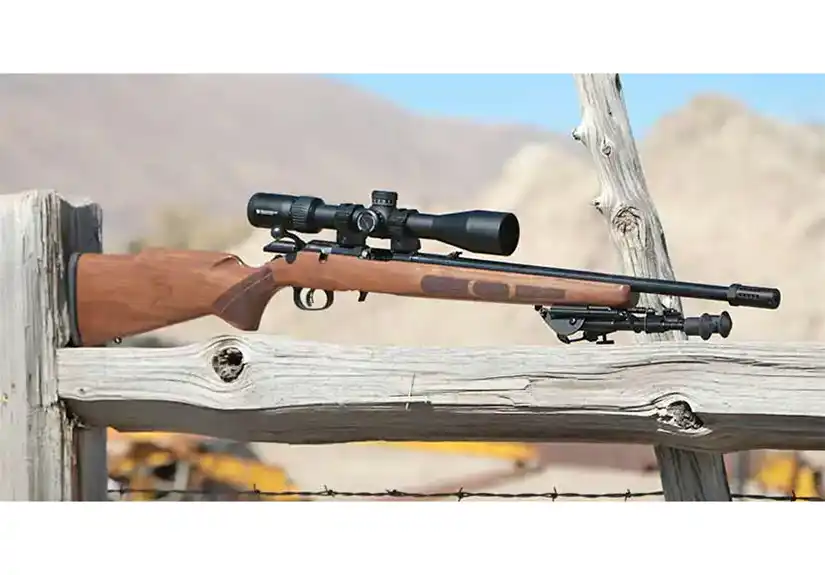Having owned a few Ruger American Rimfires in other calibers, I figured it was time to get one in .22 LR. Once I put the word out, a friend got me hooked up with one that sounded promising. It was accurate, but had extraction and ejection issues. Also, the front sight was missing, but it came with a set of quality scope rings. So the owner was willing to part with it at a more than fair price, out of frustration. After a basic function check and a peek at the bore, everything seemed in order, so I bought it with the intention of making it a bolt-action suppressor host suitable for handing down to my son one day.
Now, I’m not suggesting that anything which happened shortly after was Ruger’s fault, as most of it wasn’t. Yet it was still disheartening. I mounted a scope and took it out shooting. As advertised, it shot pretty well, with most groups easily under one inch at 50 yards. That was with a variety of bulk or inexpensive ammo. If I can get 2 MOA at 50 yards with junk ammo, I know there is room for improvement. Otherwise, it’s just another plinker. But it failed to extract and/or eject empties with alarming frequency. And then I noticed the crosshairs on my scope somehow broke. It was an inexpensive Vortex I bought used, and it turns out it was a knock-off. What kind of monster makes fake $200 scopes? Anyway, lesson learned. Always buy your optics from reputable, authorized dealers.
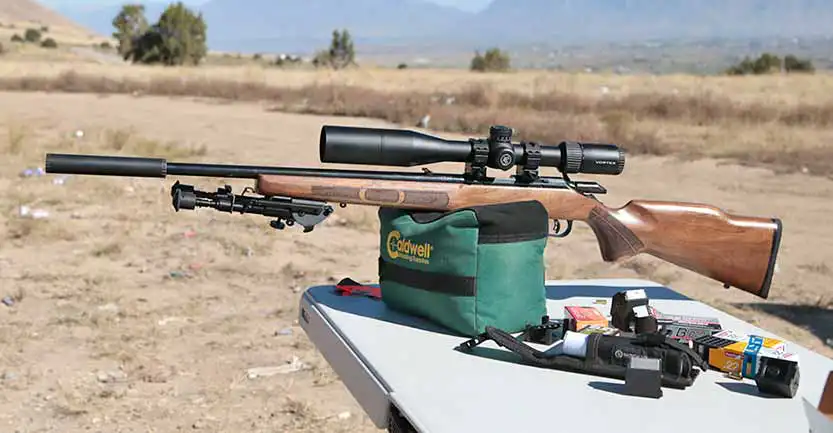
Time to fix all the things
A quick email to Ruger, and they had a new extractor and positioner spring in the mail to me. Since I had a Riton scope for review, I mounted that. But before I did that, I dropped the rifle off at a local gunsmith. He’s known for doing good work, and as the owner of the same Ruger American Rimfire rifle, knew exactly what was needed to improve the accuracy a bit more. While I was waiting for it to come back from the gunsmith, I took some Flitz to the bolt and polished it up. These little rimfire bolts don’t weigh much and don’t lock up the way larger centerfire bolts do. So they might never have that “smooth as glass” experience. But removing any rough spots makes them a bit smoother, and they wipe clean much easier as well.
My rifle came with an unthreaded 22″ barrel. When I picked it up, it was cut down to about 17.5″, threaded 1/2 x 28, and re-crowned. He assured me that I would be pleased with the accuracy, and it would still be fairly compact with the suppressor mounted. Hard to argue with that. I added a Summit Precision FNC Ported Muzzle Compensator for when the suppressor isn’t attached.
With the extractor and positioner spring installed, I took it out again. Empty brass now gets thrown clear, rather than getting stuck in the chamber or held by the positioner spring. Groups improved a bit, which could be the scope or the shorter, stiffer barrel. And with the suppressor, it felt like it might quickly become one of my favorite rifles.
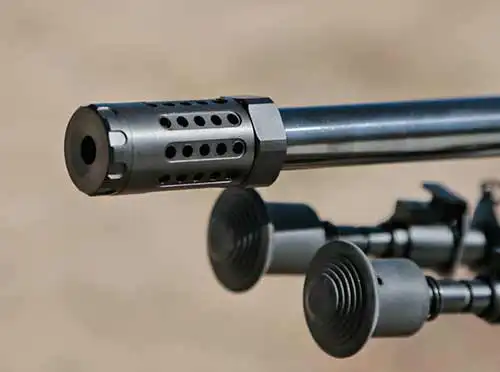
There’s such a thing as too much scope
That scope (Read the Riton review here), is a 6-24×50. Nice glass, but a bit too much for a rifle that I wanted to carry, and shoot hand-held. Now, I will be the first to admit that there is nothing tactical about a bolt-action rimfire. But I had this Vortex Diamondback Tactical 4-16×44 scope in my scope drawer. Clear glass, perfect magnification range, and it’s low-profile and reasonably light too. In other words, perfect for this project. So I mounted it and zeroed it. Aesthetically, the rifle was really starting to look nice, and I was taking a liking to it the more I shot it. Despite the lower magnification of the scope, I was starting to see groups closer to 1/2 inch than an inch at 50 yards. Definitely starting to look like a keeper.
The crowning touch, a Boyds Rimfire Hunter stock
I’ve been a fan of Boyds Gunstocks for more than a decade, since I bought my first one for a Savage MK II FV-SR. But all my previous stocks have been laminates. This time, I dropped the Ruger into a Claro X Walnut Rimfire Hunter stock, with laser-engraved checkering. As this rifle was turning into something that I might one day pass on to my son, I felt that going with an heirloom quality stock was the right approach. And when I opened that box, I knew I made the correct choice. In a world of cheap polymer stocks being the norm, it’s easy to forget the warmth that real wood can bring.
As an amateur woodworker, I’ve dabbled in my fair share of projects. Most of which were not made with premium wood like the walnut Boyds uses. This stock features very attractive grain and a nice matte finish which makes the checkering really stand out. A closer look at the checkering and fine lines surrounding it reveals the kind of even work that’s hard to produce by hand. At that point, I was pretty excited to see this rifle come together.
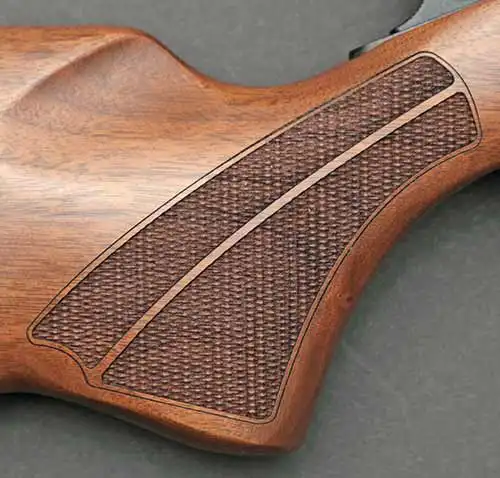
Installation of the Boyds Rimfire Hunter stock
Two screws attach the action of the Ruger American Rimfire to the factory stock. After clearing the rifle and removing the bolt, I removed those two screws from the OEM stock. One is in front of the magazine well, and the other is behind it, just ahead of the trigger guard. With the barreled action removed, it was a matter of gently prying out the bedding blocks, and carefully placing them in the new Boyds stock. Once in place, I test fit the barreled action, and it went in snugly, with no extra fitting required. Then I used a torque wrench to tighten down both screws to 35 in lbs. Although I alternated back and forth, going slowly, I checked it again about a week later, in case there was any settling after two outings. Still nice and snug.
When I rolled my stool back a bit to kind of “take in the view” of my rifle, I was very pleased. I understand plastic stocks keep costs down, but they really are utilitarian. And not every rifle has to be just a tool. Mine went from bland to elegant just by swapping out the stock. Compared to the polymer one it replaced, the Boyds Rimfire Hunter stock is a little longer in the forend, with a much more elegant comb and shorter cheekpiece. They appear almost dimensionally the same at the wrist, but with a moderately steeper grip. And the laser engraved checkering is just fantastic. I appreciate good craftsmanship from working with hand tools, but it’s hard to argue with the results here.
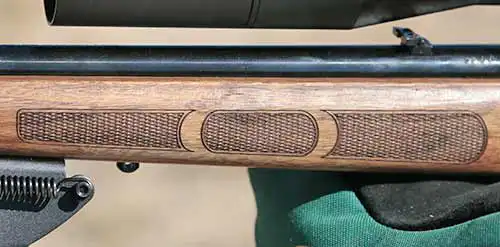
A bit more about the stock choice
Boyds laminate stocks get their stability from 37 layers of laminated wood. This makes them much stronger than solid wood, as 37 laminations and adhesive infused into every cell of the wood make them extremely rigid. In addition, they offer high color brightness along with retention. This is because the dye used to stain each layer of wood is also pushed into every single fiber of the wood. So the color is solid and uniform throughout the entire layer of the wood. And then it’s sprayed with a super-hard finish that seals the wood completely. It’s that step that locks in its bright color while permanently protecting the wood from moisture, adding to the enduring color and stability.
While that’s great for fun colors, their hardwood walnut stocks get the same level of care and attention. Boyds starts with the highest grade “select” hardwoods without defects. From there, they are dried to perfection and sealed with the most durable finishes available. This completely stabilizes the wood, leaving it impervious to heat, cold, or moisture. And that is exactly what I was after. With the stock sealed up, I don’t have to worry about weather conditions affecting my point of impact.
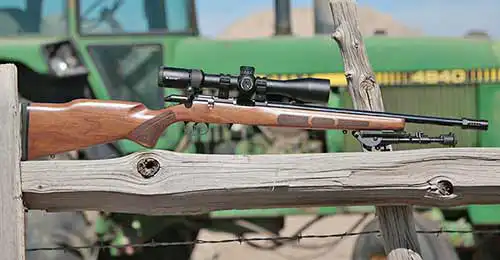
The end result
I never checked the action screws in the factory stock, but now that it’s in the Boyds, and I am experimenting with ammo, I’m seeing even smaller groups. Whether the stock is a factor or not doesn’t matter though. The reaction my rifle gets from friends and strangers tells me that it’s more than just a great shooting rifle. Checkered walnut gives it that classic look, while still retaining all the performance of a modern rifle.
Before this, I wouldn’t have thought of Ruger’s somewhat pedestrian rimfire rifle as a “luxury” firearm. But now it definitely looks more refined, and backs up those looks with solid results. I’ve changed my mind about giving it to my son though. When he has a kid of his own, and they’re old enough, I’ll pass it on to him or her. In the meantime, I’ll keep on smoothing out that action, one round at a time. And maybe I’ll find the right ammo to get it under 1 MOA.
I’d like to thank Boyds Gunstocks for providing their beautiful Claro X Walnut stock for this project.
Part two of this project involves a DNZ Game Reaper once-piece scope mount, and a scope upgrade.
